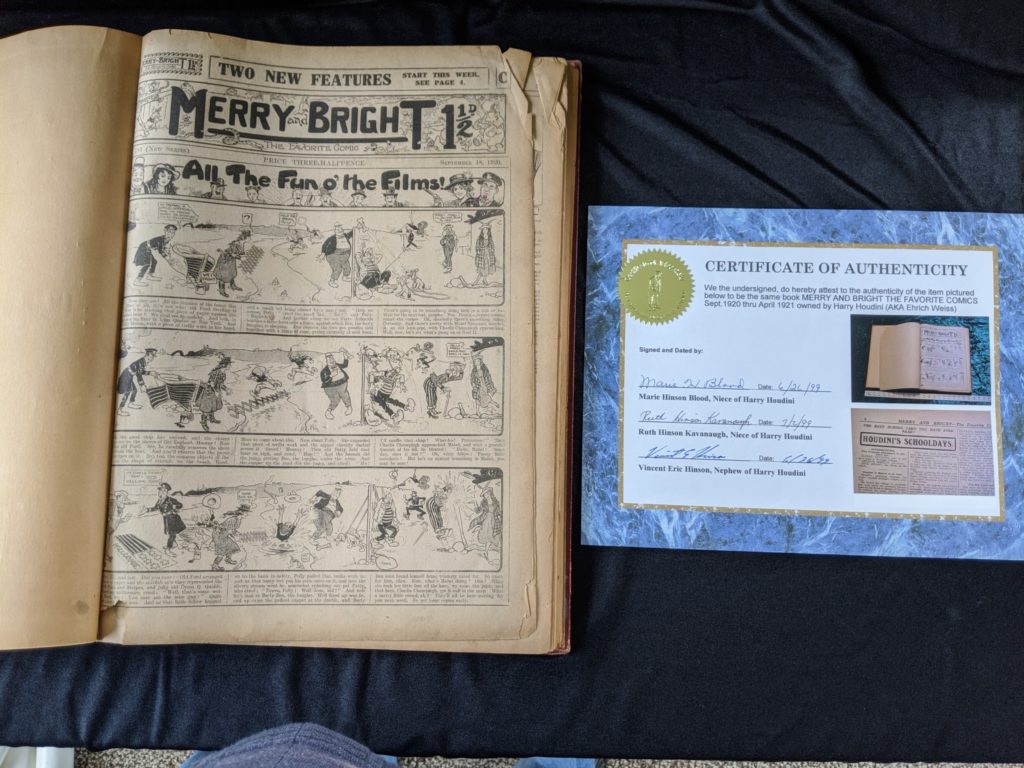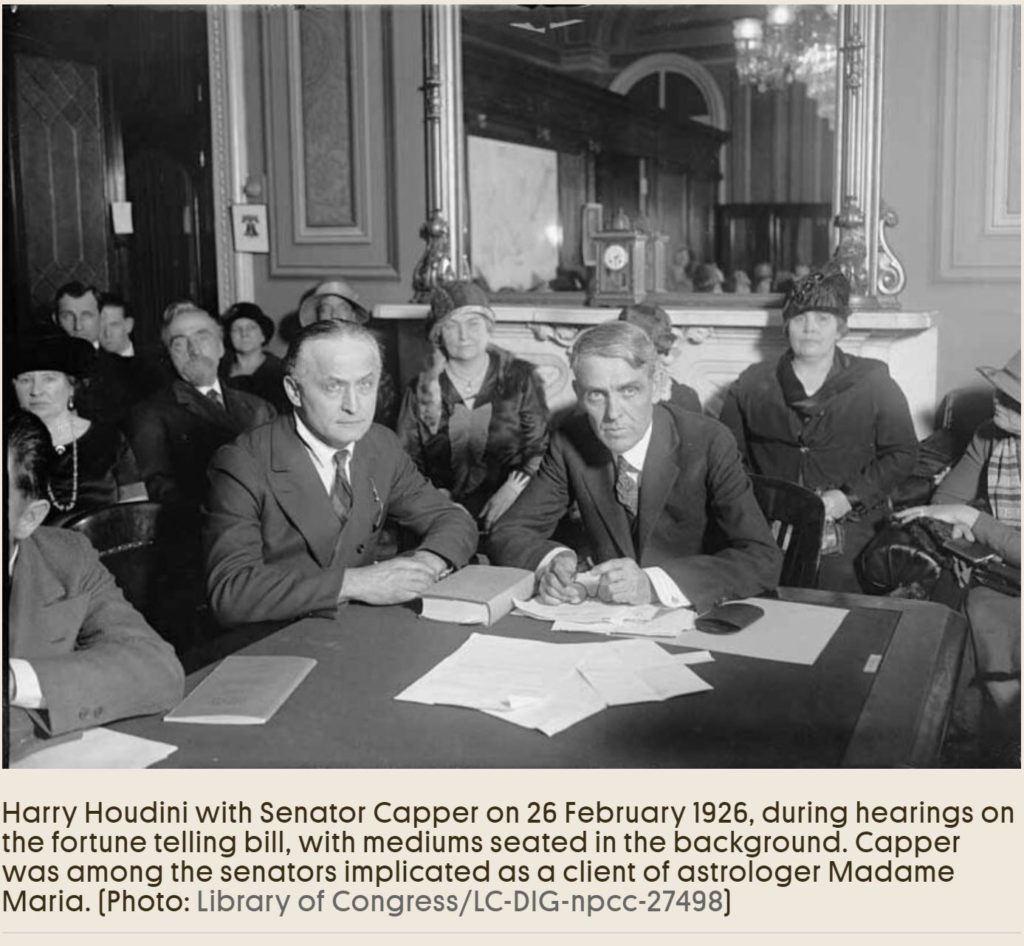Thought I would share a short Houdini article from my February 29, 1924 copy of The Vaudeville News Trade Journal that I found very interesting and packed with info for 1924.

Herbert Allingham was the writer of a number of short story series that Houdini attached his name with:
This week we explore, Allingham’s contribution to Houdini’s Schooldays.
According to Julia Jones book, Fifty Years in the Fiction Factory,
“In 1920 the escapologist Harry Houdini made a well-publicised visit to England. Merry & Bright responded to its readers’ interest by giving them Houdini’s Schooldays as their weekly serial. As the editor explained, ‘A man like Houdini could not fail to have had a wonderful early life and these stories tell of his adventures while still at school.’ In Merry & Bright’s version, however, the boy Houdini was not Erich Weiss, the rabbi’s son from Budapest, growing up impoverished in America; he was a cricket playing, boater-wearing fine young fellow at Rathgar College. He was in fact Will Holt, Allingham’s Duffer, with the Dufferish-ness reduced a fraction and the agility played up. Only a few new sentences and occasional descriptors were needed to make this happen and, apart from a change of proper nouns, Houdini’s Schooldays was simply the fourth printing of A Regular Duffer, the story that Allingham had first written in 1904 for Aldine’s True Blue. This seems to have been Allingham’s own initiative. A diary entry for 10 June 1920 states that he ‘went to New Cross and saw Houdini. Fixed up with him about school days.”
The four printings of Regular Duffer are as follows:
And I have originals of two of these in my collection.
That’s right, I am the proud new caretaker of a Merry and Bright’ book that was once owned by Harry and Bess Houdini and signed by Harry Houdini on the first page.
 This book, “Merry and Bright”, contains 30 publications of “The Favorite Comic” published in London from Sept 1920 to April 1921. “Merry and Bright” comics featuring Houdini’s Schooldays” was 8 pages of newsprint published every week. These comics include both amusing illustrations and short fictional stories. The newspaper sold in London for three halfpence english coins (1 1/2 d).
This book, “Merry and Bright”, contains 30 publications of “The Favorite Comic” published in London from Sept 1920 to April 1921. “Merry and Bright” comics featuring Houdini’s Schooldays” was 8 pages of newsprint published every week. These comics include both amusing illustrations and short fictional stories. The newspaper sold in London for three halfpence english coins (1 1/2 d).
Houdini enjoyed reading the stories and likely paid to have this book created for his personal library.
I am so excited to finally own something of Houdini’s and believe it or not, this is the only item in my collection to date that is signed by him, despite studying and collecting Houdini for over 45 years.
In a future post, I will share a condensed summary of the first 29 publications (9/18/1920 to 4/2/1921) of Houdini’s School Days leading up to the final publication (4/9/1921), Houdini’s Last Great Stunt at Rathgar.
Last year, I shared five of the six 1978 Stuart Pharmaceutical calendars from the series numbered DM-17301 to DM-17306:
And today, I share the missing September/October (DM-17305) calendar, thanks to Roger Dreyer at houdinireavealed.com and an alert from John Cox.
Related:
Herbert Allingham was the writer of a number of short story series that Houdini attached his name with:
This week we explore, Allingham’s contribution to The Amazing Exploits of Houdini.
According to Julia Jones book, Fifty Years in the Fiction Factory, “Allingham had contributed a series of Houdini stories for the Kinema Comic in which he invented a cheerful cockney named Arth Wright as a resourceful boy assistant for the escapologist and had introduced him to one of his series detectives, Pelham Webb.” And Julia’s thesis implies, “The story series had opened in 1922 and the first thirty of these ‘Amazing Exploits’ had been written by Allingham… Early in 1923 however, F.C. Cordwell, editor of The Kinema Comic, instructed Allingham to drop Houdini…Houdini was continued by other anonymous writers. ‘My price too high’, wrote Allingham in his diary.
But the ‘The Amazing Exploits of Houdini’ found in Kinema Comic, ran from April 24, 1920 to November 27, 1926.
For a complete list of all 343 issues of The Kinema Comic that contain “The Amazing Exploits of Houdini” see Houdini Periodical Bibliography References From 1898 – 2015 by Arthur Moses. Note: The Oct 27, 1923 v4 n184 issue is the only one from the run that DOES NOT contain the series.
So, I am wondering if Allingham’s contribution to Kinema Comic started in 1920 or 1922?
I have copies of the first 7 issues from 1920 and have read the October 14, 1922 issue.
It appears that the October 14, 1922 issue is when Arth Wright makes his first appearance, so that would confirm 1922.
And the first 7 issues don’t read like Allingham to me.
That said, I have tried unsuccessfully to get ahold of Julia Jones to get her thoughts on whether Allingham could have contributed to the earlier stories or were they written by others?
A diary entry for 10 June 1920 states that Allingham ‘went to New Cross and saw Houdini. Fixed up with him about school days’.
Houdini’s Schooldays Series started September 1920 in Merry and Bright, 5 months after the Amazing Exploits of Houdini series started in Kinema Comic, so…
Unfortunately, there is not an earlier diary mention for Kinema Comic, nor earlier copies of Kinema Comic than 1922 in the extraordinary archive of sixteen boxes of Allingham material that Julia Jones got to sort and collate.
 At the Fortune Telling Hearings:
At the Fortune Telling Hearings:
Houdini flashed $10,000 in U.S. currency as a challenge to any medium to tell them what his father had nicknamed him, then Madame Maria jumped up and screamed, “That money belongs to me! …” [Kalush p 482]
Kalush source was the New York Times, February 27, 1926 where it mentions:
Once he issued a general challenge to them to tell just what his mother had called him when he was a boy, but no Spirtiualist ventured to furnish that information and Houdini did not offer it.
If you think you know the answer, of what either parent of Houdini nicknamed him, please email me.
H A P P Y F A T H E R ‘ S D A Y !
Herbert Allingham was the writer of a number of short story series that Houdini attached his name with:
This week we explore the not widely known, Jorkins & Co.
According to Julia Jones (author of Fifty Years in the Fiction Factory), ‘Jorkins & Co’, was a short story series developed from The Duffer, Detective (True Blue, 1906), and ascribed in Film Fun to Houdini, the Handcuff King.
Below is Julia Jones summary, along with some Chapter I excerpts of The Duffer, Detective:
‘Holt [aka The “Duffer” or “Houdini”] of Emmanuel’ is no timid non-collegiate student but a young man with ‘a certain easy swagger in his walk’. He is however, short of cash (trouble with the trustees) so has summoned his old school friend, Arthur Merlin, down first-class from London in order to make use of Merlin’s L500 inheritance. Holt needs money to rescue an acquaintance called Jorkins, who has taken over his father’s jewellery shop in Clerkenwell and has subsequently disappeared. Merlin is not instantly enthusiastic.
‘Can’t you see that you are spoiling your life for the sake of a silly juggins who is probably in no trouble at all and who, even if he is, is not worth saving?’
‘Jorkins is my friend,’ replied Holt gravely.
Merlin sprang to his feet impatiently and walked nervously up and down the room.
‘Oh, of course,’ he cried irritably, ‘I know it’s no use arguing with you. Well what is the idiotic programme? Suppose I refuse to let you have a penny of my money?
Over the Duffer’s face came the charming smile which Merlin could never resist in the old days
‘In that improbable event,’ he replied, sweetly, ‘I should go to London and accept a situation as a clerk that has been offered to me at eighteen shillings a week, and in the evenings I should pursue my investigations.’
Merlin relents of course.
‘Oh Duffer,’ he cried,’ You are hopeless. Well we’ll have some fun and when our five hundred is spent we’ll go into the workhouse together.’
‘The workshouse! My dear Merlin, what an unpleasant suggestion! On the contrary when we have spent all our money we will earn some more. Really I begin to hope that my trustees will not relent. It would be rather fun to work for one’s living.’
‘Not much fun clerking on eighteen shillings a week, Merlin suggested.
Allingham’s young men gallop out of Cambridge, knocking over the university proctor and his ‘bulldogs’.
‘Forward Merlin!’ cried the Duffer. ‘There is no time to apologise now. I must write to the the good man from town.’ Dons and townsfolk try to block their exit but Merlin and the Duffer are saved by a crowd of undergraduates.
The next moment the gallant steed with its double burden was thundering down the lane.
It bore them across Parker’s Piece, in an out of the narrow streets beyond and then across the green that borders the River Cam.
They heard behind them a terrific uproar and it was clear that Town and Gown had come to blows but the pursuit was not continued.
‘It seems they’ve had enough of you, Duffer,’ said Merlin. ‘I fear your ‘Varsity career closes today.’
‘I fear so,’ admitted the Duffer, rather sadly. ‘It’s been a very happy time, but when duty calls one must not hesitate. Jorkins cries to us for help and he shall not cry in vain.’
While I have been unable to locate a copy of Film Fun’s “Jorkins & Co” (aka The Duffer, Detective) yet, I do have a copy of True Blue’s “The Duffer, Detective” (by David Pitt aka Herbert Allingham) which was 7 chapters:
Just received a copy of November/December 2020 Michigan History magazine with an article inside about “Houdini in Detroit” by Jeremy Dimick, director of collections at the Detroit Historical Society.
While there are few errors regarding dates, it is very well done.
It covers Houdini’s performances in Detroit from when he was relegated to the Curio Hall to his performances as a headliner.
A few things of interest caught my attention:

You can purchase Michigan History HERE.
Below are B&W and color images of the “Apology in the Name of the Kaiser” poster that we are most familar with:
In 2018, our friend John Cox at Wild About Houdini, did a post on a poster variant:

Variant #1 tipped in a “Unmasking” book and also found on p8 of Houdini on Magic by Walter B. Gibson
Well, I recently came across another variant:
Bonus:
We are all familiar with the famous “doctored” photo of Houdini and Theodore Roosevelt originally taken of a group by Franz Kukol
And many of us have seen the group photo that actually shows 7 people in the photo: Wm. H Childs, Houdini, J.C. Platt, Theodore Roosevelt, A.W. Erickson, Philip Roosevelt, and L.F. Abbott
But have you seen the photo with 8 people?
And anyone know who that 8th person is on the far right of the photo?
Could it be Mr. Ridgeway mentioned in the letter (first posted by our friend, David Saltman on his Houdini File site) from William Hamlin Child’s about the “fake picture” of Houdini and Roosevelt.
Related:
Harry Houdini wrote a short novel in 1925, a romantic detective thriller, called The Zanetti Mystery (ghostwritten of course).
Houdini builds his story about the monstrous figure of Zanetti — genius faker, and arch rogue; he shows the methods by which even profound scientists have been hoodwinked by prophets of the occult and materializers of demons and spirits, and tells of the private lives often rivaling Babylon in abandon and luxury– of those who strip both rich and poor by mystery and mummery.
Through the whole fabric of the story there move the amazing characters of the half-world and underworld spies “snowbirds”, “lobby gows”, “stoppers”, “floppers”, “controls”, and “falls”, whom only Houdini can write about, because his special investigations have made him know them all and how they work as links in a chain system which is one of the weirdest forces for fraud and evil in the world. [The Journal]
The short novel (8 Chapters) was serialized over eight weeks in various Newspapers.
This week, I share Chapter 8 (Prologue) of 8:
CHAPTER VIII
Prologue:
HERMAN STEINWAY, an aged millionaire, is being victimized in his belief in spirits by a most notorious faker, Zanetti, who agrees to produce the spirit of the millionaire’s deceased wife, in the flesh, for one million dollars. Van Haarlem, Zanetti’s chief detective, is put on the job. He induces the Gopher, an ex-convict to break into Steinway’s home for a photograph of the dead woman. With this in hand, Van Haarlem sets out to find a girl who tallies with the description of this woman.
Meanwhile, the District Attorney has been cleaning up the spiritualistic fakers. Wallace Haines, Assistant District Attorney, is given the assignment. Wallace has just become engaged to marry Lucile Linton, an ex-chorus girl now doing charity work in the slums. She promises to help Haines in his work. Van Haarlem finally appeals to the Gopher to help him locate a girl for the illusion, and Lucile, who has been visiting the Gopher’s crippled child, offers herself, in the guise of a charity. Van Haarlem takes Lucille to see Zanetti.
Lucille is accepted for the role and the seance is staged. Haines conducts a raid on the place at Lucile’s signal but Lucile discovers, a moment too late, that the old man is her own father. She tries to keep out the raiders while her father is dying of heart failure. Haines believes she has tricked him and he denounces her. Meanwhile while Zanetti and his men escape.
Lucile is held for murder. Haines, realizing his hasty judgment, makes amends by resigning his desk and preparing Lucile’s defense.